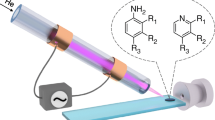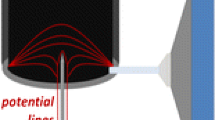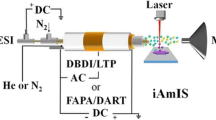Abstract
Ambient ionization mass spectrometry (AI-MS), the ionization of samples under ambient conditions, enables fast and simple analysis of samples without or with little sample preparation. Due to their simple construction and low resource consumption, plasma-based ionization methods in particular are considered ideal for use in mobile analytical devices. However, systematic investigations that have attempted to identify the optimal configuration of a plasma source to achieve the sensitive detection of target molecules are still rare. We therefore used a low-temperature plasma ionization (LTPI) source based on dielectric barrier discharge with helium employed as the process gas to identify the factors that most strongly influence the signal intensity in the mass spectrometry of species formed by plasma ionization. In this study, we investigated several construction-related parameters of the plasma source and found that a low wall thickness of the dielectric, a small outlet spacing, and a short distance between the plasma source and the MS inlet are needed to achieve optimal signal intensity with a process-gas flow rate of as little as 10 mL/min. In conclusion, this type of ion source is especially well suited for downscaling, which is usually required in mobile devices. Our results provide valuable insights into the LTPI mechanism; they reveal the potential to further improve its implementation and standardization for mobile mass spectrometry as well as our understanding of the requirements and selectivity of this technique.

Optimized parameters of a dielectric barrier discharge plasma for ionization in mass spectrometry. The electrode size, shape, and arrangement, the thickness of the dielectric, and distances between the plasma source, sample, and MS inlet are marked in red. The process gas (helium) flow is shown in black





Similar content being viewed by others
References
Takats Z, Wiseman JM, Gologan B, Cooks RG. Mass spectrometry sampling under ambient conditions with desorption electrospray ionization. Science. 2004;306:471–3.
Cody RB, Laramée JA, Durst HD. Versatile new ion source for the analysis of materials in open air under ambient conditions. Anal Chem. 2005;77:2297–302.
Chen H, Venter A, Cooks RG. Extractive electrospray ionization for direct analysis of undiluted urine, milk and other complex mixtures without sample preparation. Chem Commun (Cambridge, UK). 2006:2042–4.
Haddad R, Sparrapan R, Kotiaho T, Eberlin MN. Easy ambient sonic-spray ionization-membrane interface mass spectrometry for direct analysis of solution constituents. Anal Chem. 2008;80:898–903.
Ratcliffe LV, Rutten FJM, Barrett DA, Whitmore T, Seymour D, Greenwood C, et al. Surface analysis under ambient conditions using plasma-assisted desorption/ionization mass spectrometry. Anal Chem. 2007;79:6094–101.
Harper JD, Charipar NA, Mulligan CC, Zhang X, Cooks RG, Ouyang Z. Low-temperature plasma probe for ambient desorption ionization. Anal Chem. 2008;80:9097–104.
Shiea J, Huang M-Z, Hsu H-J, Lee C-Y, Yuan C-H, Beech I, et al. Electrospray-assisted laser desorption/ionization mass spectrometry for direct ambient analysis of solids. Rapid Commun Mass Spectrom. 2005;19:3701–4.
Sampson JS, Hawkridge AM, Muddiman DC. Generation and detection of multiply-charged peptides and proteins by matrix-assisted laser desorption electrospray ionization (MALDESI) Fourier transform ion cyclotron resonance mass spectrometry. J Am Soc Mass Spectrom. 2006;17:1712–6.
Nemes P, Vertes A. Laser ablation electrospray ionization for atmospheric pressure, in vivo, and imaging mass spectrometry. Anal Chem. 2007;79:8098–106.
Olenici-Craciunescu SB, Michels A, Meyer C, Heming R, Tombrink S, Vautz W, et al. Characterization of a capillary dielectric barrier plasma jet for use as a soft ionization source by optical emission and ion mobility spectrometry. Spectrochim Acta Part B. 2009;64:1253–8.
Chan GC-Y, Shelley JT, Wiley JS, Engelhard C, Jackson AU, Cooks RG, et al. Elucidation of reaction mechanisms responsible for afterglow and reagent-ion formation in the low-temperature plasma probe ambient ionization source. Anal Chem. 2011;83:3675–86.
Andrade FJ, Wetzel WC, Chan GC-Y, Webb MR, Gamez G, Ray SJ, et al. A new, versatile, direct-current helium atmospheric-pressure glow discharge. J Anal At Spectrom. 2006;21:1175.
Andrade FJ, Shelley JT, Wetzel WC, Webb MR, Gamez G, Ray SJ, et al. Atmospheric pressure chemical ionization source. 2. Desorption-ionization for the direct analysis of solid compounds. Anal Chem. 2008;80:2654–63.
Na N, Zhao M, Zhang S, Yang C, Zhang X. Development of a dielectric barrier discharge ion source for ambient mass spectrometry. J Am Soc Mass Spectrom. 2007;18:1859–62.
Golubović J, Birkemeyer C, Protić A, Otašević B, Zečević M. Structure–response relationship in electrospray ionization-mass spectrometry of sartans by artificial neural networks. J Chromatogr A. 2016;1438:123–32.
Abburi R, Kalkhof S, Oehme R, Kiontke A, Birkemeyer C. Artifacts in amine analysis from anodic oxidation of organic solvents upon electrospray ionization for mass spectrometry. Eur J Mass Spectrom. 2012;18:301–12.
Na N, Zhang C, Zhao M, Zhang S, Yang C, Fang X, et al. Direct detection of explosives on solid surfaces by mass spectrometry with an ambient ion source based on dielectric barrier discharge. J Mass Spectrom. 2007;42:1079–85.
Huang G, Xu W, Visbal-Onufrak MA, Ouyang Z, Cooks RG. Direct analysis of melamine in complex matrices using a handheld mass spectrometer. Analyst. 2010;135:705–11.
Liu Y, Ma X, Lin Z, He M, Han G, Yang C, et al. Imaging mass spectrometry with a low-temperature plasma probe for the analysis of works of art. Angew Chem Int Ed Engl. 2010;49:4435–7.
Wiley JS, Shelley JT, Cooks RG. Handheld low-temperature plasma probe for portable "point-and-shoot" ambient ionization mass spectrometry. Anal Chem. 2013;85:6545–52.
Hayen H, Michels A, Franzke J. Dielectric barrier discharge ionization for liquid chromatography/mass spectrometry. Anal Chem. 2009;81:10239–45.
Kogelschatz U. Dielectric-barrier discharges: their history, discharge physics, and industrial applications. Plasma Chem Plasma Process. 2003;23:1–46.
Hagenhoff S, Franzke J, Hayen H. Determination of peroxide explosive TATP and related compounds by dielectric barrier discharge ionization-mass spectrometry (DBDI-MS). Anal Chem. 2017;89:4210–5.
Kiontke A, Oliveira-Birkmeier A, Opitz A, Birkemeyer C. Electrospray ionization efficiency is dependent on different molecular descriptors with respect to solvent pH and instrumental configuration. PLoS One. 2016;1:e0167502.
Liu J, Wang H, Manicke NE, Lin J-M, Cooks RG, Ouyang Z. Development, characterization, and application of paper spray ionization. Anal Chem. 2010;82:2463–71.
Hu B, So P-K, Chen H, Yao Z-P. Electrospray ionization using wooden tips. Anal Chem. 2011;83:8201–7.
Kerian KS, Jarmusch AK, Cooks RG. Touch spray mass spectrometry for in situ analysis touch spray mass spectrometry for in situ analysis of complex samples. Analyst. 2014;139:2714–20.
Meher AK, Chen Y-C. Tissue paper assisted spray ionization mass spectrometry. RSC Adv. 2015;5:94315–20.
Quinn KD, Cruickshank CI, Wood TD. Ultra high-mass resolution paper spray by Fourier transform ion cyclotron resonance mass spectrometry. Int J Anal Chem. 2012;2012:382021.
Karakas E, Koklu M, Laroussi M. Correlation between helium mole fraction and plasma bullet propagation in low temperature plasma jets. J Phys D Appl Phys. 2010;43:155202.
Urabe K, Ito Y, Sakai O, Tachibana K. Interaction between dielectric barrier discharge and positive streamer in helium plasma jet at atmospheric pressure. Jpn J Appl Phys. 2010;49:106001.
Joh HM, Kim SJ, Chung TH, Leem SH. Comparison of the characteristics of atmospheric pressure plasma jets using different working gases and applications to plasma–cancer cell interactions. AIP Adv. 2013;3:92128.
Walsh JL, Kong MG. Contrasting characteristics of linear-field and cross-field atmospheric plasma jets. Appl Phys Lett. 2008;93:111501.
Pedersen PO. Über den elektrischen Funken. I. Teil: Funkenverzögerung. Ann Phys. 1923;376:317–76.
Grove TT, Masters MF, Miers RE. Determining dielectric constants using a parallel plate capacitor. Am J Phys. 2005;73:52–6.
Humud HR, Obayes TK, Abbas QA. Electrodes configuration effect on some properties of low temperature plasma jet (LTPJ). IJCET. 2004;4:2580–4.
Acknowledgements
The authors thank Dr.-Ing. Susan Billig, Ramona Oehme, Josef J. Heiland (all from the University of Leipzig, Germany), and Aigerim Galyamova (Penn State University, USA) for their technical assistance. We also thank Prof. Frank-Dieter Kopinke (Helmholtz Centre for Environmental Research, Leipzig, Germany) for his valuable critical hints regarding manuscript writing. In addition, we thank Prof. em. Berger (University of Leipzig, Germany) for kind and constant support. This work was financed by the Deutsche Bundesstiftung Umwelt (DBU grant no. 20015/375), the European Regional Development Fund (ERDF, Europäischer Fond für Regionale Entwicklung EFRE, “Europe funds Saxony,” grant no. 100195374), the German Academic Exchange Service (DAAD “Rise” program 2016), and the University of Leipzig.
Author information
Authors and Affiliations
Corresponding authors
Ethics declarations
Conflict of interest
The authors declare that there is no conflict of interest relating to this work.
Electronic supplementary material
ESM 1
(PDF 583 kb)
Rights and permissions
About this article
Cite this article
Kiontke, A., Holzer, F., Belder, D. et al. The requirements for low-temperature plasma ionization support miniaturization of the ion source. Anal Bioanal Chem 410, 3715–3722 (2018). https://doi.org/10.1007/s00216-018-1033-7
Received:
Revised:
Accepted:
Published:
Issue Date:
DOI: https://doi.org/10.1007/s00216-018-1033-7




